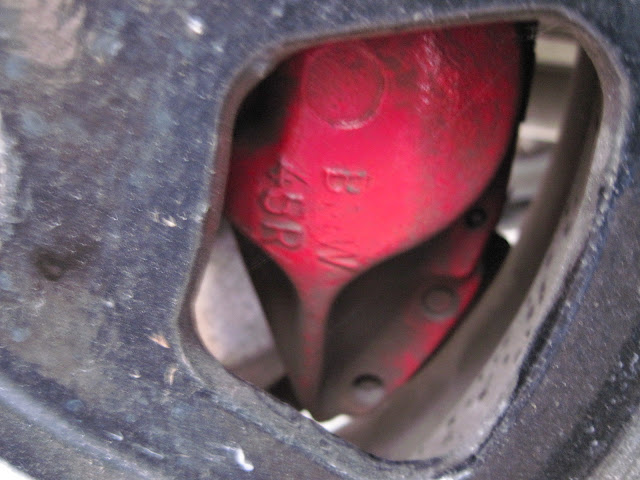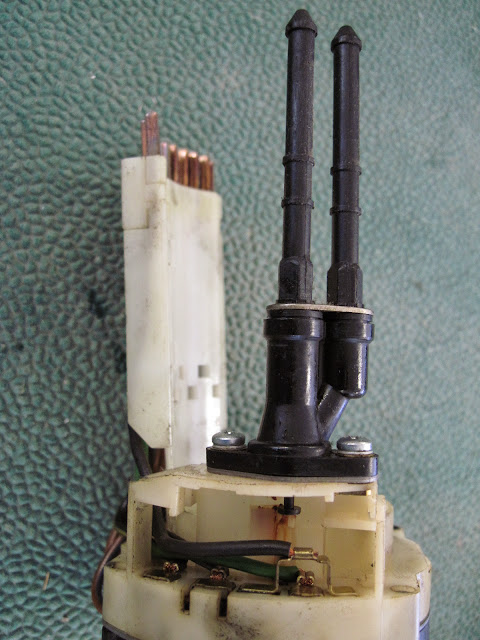Fred came over on Sunday, bearing pizza. Feeling satisfied after a good lunch, we laid out our strategy.
First we removed the axles from the transmission at the CV joints. Using the star driver, it was easy. The driver's side axle can be locked with the emergency brake, but on the passenger side I had to wedge my knees against the wheel and hold it with my hands. The important thing is to put a bag over the axle end because it's a greasy mess. You can zip-tie the passenger axle to the spring to keep it out of the way, but the driver's side is impeded by the starter motor. You just have to work around it as you roll the engine out.
I have two hydraulic jacks, as you can see below. We used a furniture dolly and two 2x4s, and brought the jacks up to just take the weight of the engine + transmission.
I removed the two bolts holding the engine brace, then the two nuts holding the transmission, and in 5 minutes the engine is no longer attached to the car. The plan was to drop the front by a few millimeters, then the back, then the front, etc. That worked well for an inch or so, but then the front jack lost its lock and slipped all the way down. We tightened it up and jacked it back up about six inches. We then dropped it evenly until the back jack was down as far as it would go. We let the front down all the way, then brought that jack around to take the load off the back, then gently let the back down. Whew! Would have been better to have two of the blue style jacks, but it worked out.
A final issue popped up - even with the car up on jack stands, the car body was a few inches too low to roll the engine out. We thought about using the hydraulic jack to raise each side and get a few more clicks on each jack stand, but that would involve a stack of 2x4s to get the needed height and I wasn't comfortable with that. Then I remembered we had just taken several hundred pounds of the car, so I walked around to the back and lifted the car up. It actually went up a few inches, so Fred raised the jack stands on each side as I lifted. That gave us the extra space we needed. I carefully rolled backwards, maneuvering around the driver's side axle and the tubing on top. And here we are!
The engine and transmission are strikingly big for the place where they fit in the little car - hard to believe the clever Germans actually fit it all in. Here's the big empty space from above and below.
We still had some light left, so we decided to pop the transmission off the engine. I'll reuse the flywheel, clutch and transmission with the electric motor. That way I can shift it like a normal car if needed. There are four bolts holding the transmission to the engine. We got three of them off easily, but the head of the fourth bolt was obscured by where it's located on the starter motor flange, and we couldn't get a socket or open-end wrench on it. After some creative metalworking (because I won't be reusing the starter), we got the bolt out but discovered that this bolt is very long, and goes all the way through the engine mount to an exposed nut. All we had to do was back the nut off from the other side. Oh well! We wiggled the transmission a little and it separated from the engine. Fred supported it while I pulled them apart and it came off easily.
Next step is to take the pressure plate, clutch disc and flywheel off the back of the engine. The pressure plate came off easily, after we jammed a 2x4 into the teeth of the flywheel to stop it from spinning. I got some repair receipts with the car that show that the clutch was replaced in the past, and both the pressure plate and clutch disc look great. They're both about .375" thick - I'll have to check to see how that compares with new, or if they should be replaced while I'm in there. Also, they're both clean and dry - no sign of oil leaks that mean that they're ruined.
We tried to work on removing the flywheel, but the 5 bolts holding it on the engine just didn't want to release, even with my cordless impact wrench. We gave it a good spraying with WD-40 and wrapped up for the day. Probably my most productive day so far, and a lot to show for it! I'll have to do some checking to see if there's a trick to get these bolts out. I'll probably need to lock the driveshaft somehow.










